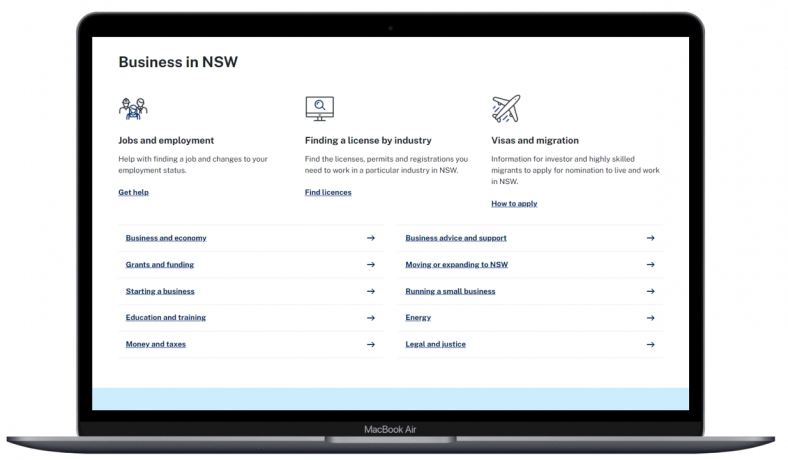Exploring the new information architecture for nsw.gov.au
With the goal of becoming the world’s most customer-centric government, nsw.gov.au has recently updated its information architecture to improve the customer experience.
Why update information architecture?
Government websites have traditionally been designed around the structure of government. As we grow nsw.gov.au to become the central source of NSW Government information online, a customer-centric IA will ensure users can locate information and complete tasks with ease, saving time and effort.
There are currently over 750 websites across NSW Government, each with their own style, layout and navigation menus. Different graphics and tone of voice also create a fragmented user experience.
As part of the OneCX program, agencies across government are working with the NSW Digital Channels team to migrate websites to nsw.gov.au. This brings information across to one platform in plain English, in a single content management system, across one customer-centric website. With such a spectrum of information on one site, a customer-focussed, research-based IA is an absolute must.

Topic pillars on nsw.gov.au
The strategy was to create topic pillars focussed on user behaviour, rather than have content structured by government departments. The main topics were selected after several rounds of user research, with focus groups totalling 500 participants representing a cross-section of the NSW customer base.
Participants were asked, for example, how they would navigate nsw.gov.au to find information about financial assistance after flood events, or understanding the rules of strata living. Their responses and the terms they used now shape the new IA, with 20 main topics selected. All new and existing content published on nsw.gov.au will sit under these topics.
Agencies have also had the opportunity to provide input into the final 20 topics to ensure that the content that they publish can sit within this structure.
User research is conducted quarterly to help us understand navigation patterns across topics on nsw.gov.au, as well as continual of testing of the 20 topics.
The new taxonomy of topics continues to perform well in unmoderated tree testing. Over half of the topics had a success rate of 75 per cent or more, with a higher success rate expected in the live environment which includes search functionality and navigation menus. This shows a high level of concordance with the way content is being organised and real users’ understanding.
The volume of information on nsw.gov.au can be a challenge for users, however findings suggest that on-page navigational components help users orient themselves.

Topic landing pages
Each topic has a landing page, which includes a mix of curated and automated content. Trending and popular content will appear near the top of the page, and any sub-topics requiring promotion can be manually added to the mix. Media releases and news, latest events, grants and resources related to the topic will automatically be displayed, saving content editors time from having to amend the layout when new content is published.
About NSW Key facts about NSW including information about the State flag, emblems, Premiers and Aboriginal culture and heritage. | Arts and culture Information about galleries, museums, libraries, performing arts and culture in NSW. | Business and economy Information for small businesses, industry licences and permits and mental health at work. | Community services Information about aged care, services for people with disability, carers and refugees. | Driving, boating and transport Information about driving and boating in NSW including licenses, registration, public transport, walking and cycling. |
Education and training Services and information to support people on their journey from childcare to preschool to further education. | Emergencies Information about disasters, disaster recovery, grants and funding and emergency services. | Employment Step-by-step guides on getting your first job, starting a new career and finding a new job. | Energy Information on energy saving, clean and renewable energy, hydro and solar energy. | Environment, land and water Information about NSW national parks, wildlife, coasts and waterways, air quality and climate change. |
Family and relationships Information on births, deaths and marriages including certificates and family history search. | Grants and funding Search and apply for grants and funding information from across NSW Government. | Health Information about health and wellbeing including hospitals, local health districts, mental health and active lifestyle. | Housing and construction Information about renting, strata rules and regulations, rent assistance, social and affordable housing, buying and selling property, and home safety. | Money and taxes Information about finance, concessions and rebates, voucher and support, and grants and funding. |
NSW Government Information about the structure of government, how government works, the Premier and Cabinet. | Legal and justice Information about fines and penalties, going to court, legal assistance and youth justice. | Sport and recreation Information about sport and recreation in NSW including safety on waterways, recreational fishing and staying active and healthy. | Visas and migration Information for business and investor migrants, and highly skilled migrants, to apply for nomination to live and work in NSW. | Visiting and exploring NSW Information about visiting Sydney, Regional NSW, and national parks in NSW. |
How does tagging content improve the customer experience?
All content on nsw.gov.au is now carefully tagged by topic. Content can also have additional tags for region, industry, and audience, to name a few. This assists with improved search and filtering on the site and also helps to serve related content to a customer which they may not have otherwise discovered.
For example, consider a business owner recently affected by the floods. Through the flood pages, they can access centralised disaster relief information to support their family and business. Related information is also served on the same page, and the business owner discovers they can also access resources for small businesses, or mental health support through free programs to reconnect and socialise.
Tagging also helps to deliver more focused data and insights to further improve our content offering, and will assist with personalisation of content in the future. For example, if we know the user is a young person, we can serve them content that has an audience tag of “young people”. Multiple tags could also be used to filter and personalise content, such as seniors in regional areas of NSW. Tagging also provides us with more defined analytics so that we can report on all segments from page level right up to cluster level.

Continuous improvement
The topics and sub-topics taxonomies are continually reviewed as more content is added to nsw.gov.au, to ensure that the terminology continues to make sense to our users.
Future improvements include ‘mega menus’ that will surface the main topics under the main navigation items of ‘Living in NSW’ and ‘Working and business’. The mega menus will allow users to quickly find the topic they are looking for, and also be exposed to other topics they may be interested in. The mega menus will also have a “featured” or “popular right now” section to promote any campaigns or content that are relevant to what is currently happening in NSW. Having the mega menus in place will expose more relevant links to users both on mobile and desktop.
Stay in touch
Want to know more about the OneCX program? Subscribe to our newsletter for the latest news and updates.